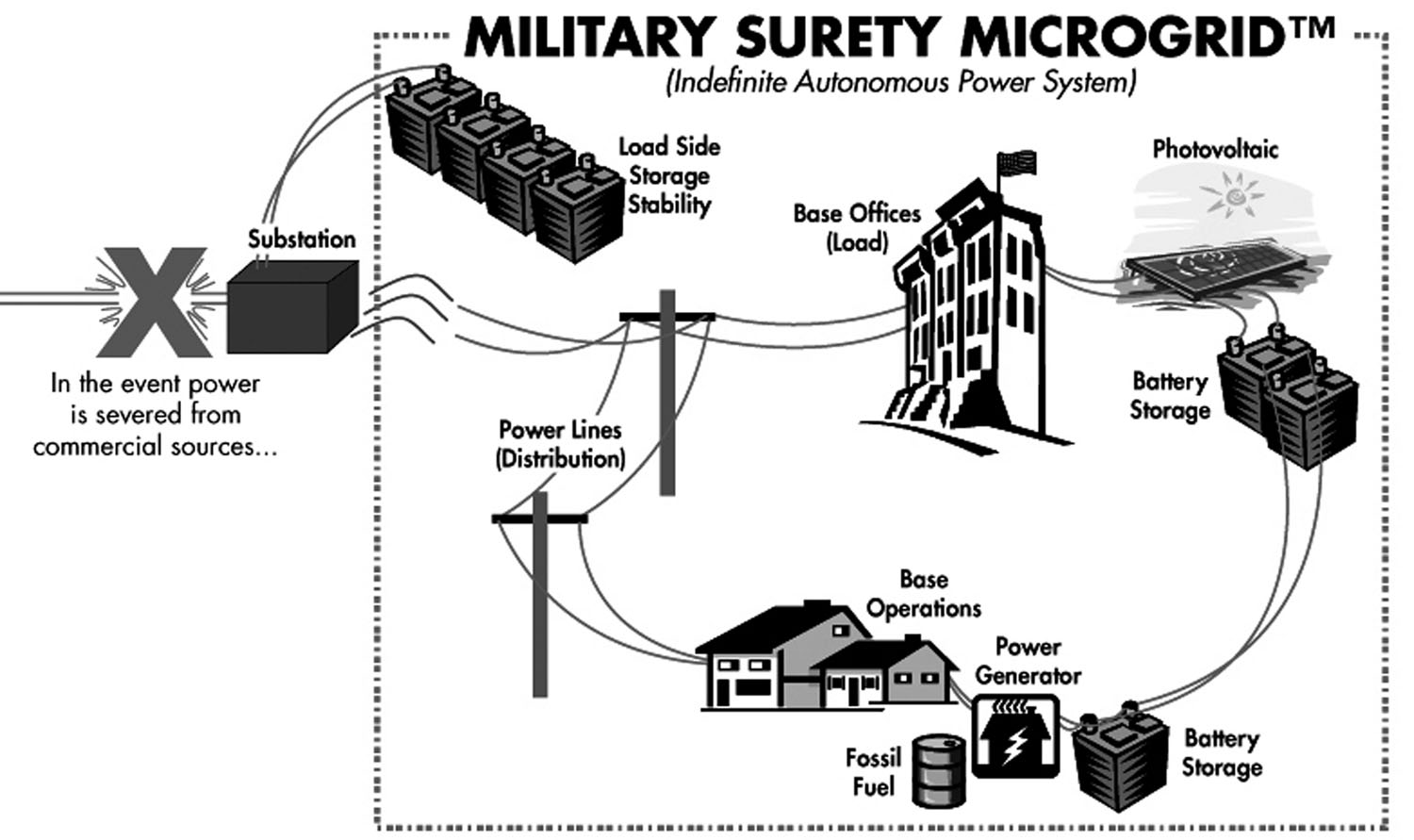 |
| Cpl. Christopher Johns A
Solar panel gathers light from the sun to provide energy aboard Marine Corps Air Station Miramar, Calif., Jan. 13. These panels perform one of two jobs aboard the installation, warming water used by service members in their homes or at the barracks, or storing solar energy to bolster power supplied by methane-powered generators at the Miramar Landfill |
 |
| Sandia Microgrid Energy Storage Concept |
MCAS Miramar
Primus Power, a manufacturer of grid-level energy storage solutions, has received a contract to develop an energy storage system that will be used with a microgrid at the United States Marine Corps Air Station (MCAS) in Miramar, California. A microgrid is a small-scale grid that includes energy generation, distribution, and loads. A microgrid might be connected to the larger grid but it also needs the ability to operate independently.If its primary method of generating energy comes from renewables like solar and wind, then a microgrid must include storage as well. Its immunity to major grid malfunctions - whether caused by nature, human error, or sabotage - makes a microgrid an ideal solution for a military base. Above is an early model of a microgrid, courtesy of Sandia National Laboratories
 |
| Each Primus battery system contains 14 fridge-size cells, which collectively store 1,000 kilowatt-hour of energy. Puget Sound is set to get two systems while the Marine Corps. will get one. |
 |
| Raytheon engineers Scott Baron and Ryan Faries test the Intelligent Power and Energy Management control system on a simulated microgrid at the National Renewable Energy Laboratory. |
DVIDS - News - Energy assurance only a microgrid away
“[A microgrid] gives us the ability to generate and move energy where we want it as well as energy assurance,” said Col. John Farnam, MCAS Miramar commanding officer. “I can control (whether) buildings get energy or not, when we need to turn it on and off, and we couple that with the constant energy coming from the landfill we have the ability to support ourselves should the rest of California go dark.”
If MCAS Miramar was its own power source, then the air station would theoretically be able to support the city should a natural disaster occur and cut electricity to San Diego, Farnam explained.
Officials at Miramar are learning from other microgrids in the area like the University of California at San Diego, Borrego Springs and also from Marine Corps Air Ground Combat Center Twentynine Palms, Calif., which is already its own microgrid.
Distributed energy in the US - Cogeneration & On-Site Power Production
An on-site renewable power installation at the US Marine Corps Air Station (MCAS) in Miramar, California, is to gain a battery energy storage system in order to become a microgrid. A 250 kW, 1 MWh battery system from Primus Power, called the EnergyPod, will be integrated with the air station's existing 230 kW PV array this year. The combined microgrid system is expected to reduce the station's peak electrical demand on weekday afternoons and power critical military systems when grid power is unavailable.
The installation is part of the air station's plan to rely solely on on-site power by 2017, and to generate enough electricity to support the surrounding city of San Diego in the event of a grid outage.
Related/Background
- Here Comes A 'Flow Battery' Technology And A $20M Plan To Bring It To Market
- Primus Power Gets A $20M Jolt For Grid-Scale Energy Storage | TechCrunch
- Leading the Charge - Microgrids for Domestic Military Installations julyaug2013-2258280.pdf By Scott Van Broekhoven, Nicholas Judson, James Galvin, and Jeffrey Marqusee
- Microgrids for the Department of Defense- Scott V.pdf
- DOD Marine Corps Air Station Miramar Microgrid Energy Storage System (pdf)
- Raytheon: How to Build a Power Base - Raytheon tech points the way to independent energy
- Energy Systems Integration: NREL + Raytheon (Fact Sheet), NREL (National Renewable Energy Laboratory) - 63974.pdf
No comments:
Post a Comment